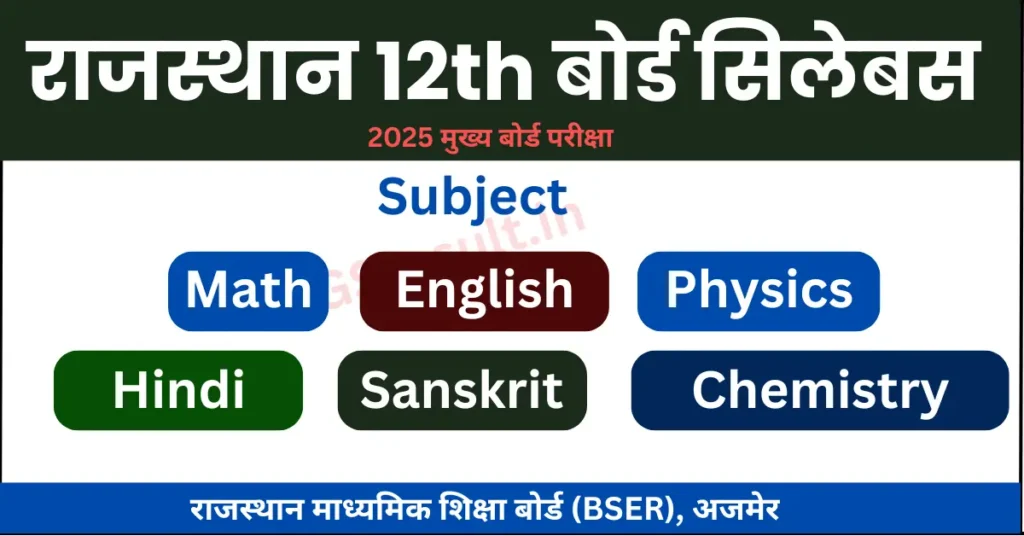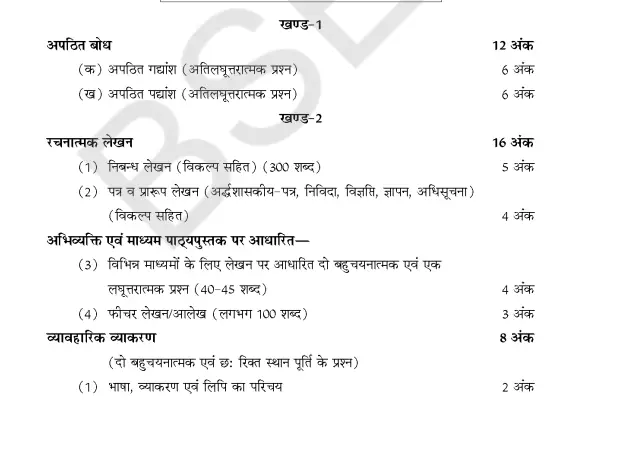Rajasthan BSER 12th Board Syllabus 2024-25: The Board of Secondary Education Rajasthan, Ajmer RBSE has declared the syllabus of the 12th board examination 2025. 12th science syllabus 2025, 12th arts syllabus 2025, 12th Biology syllabus, 12th Maths Syllabus after 30% cut. 12th agriculture syllabus, 12th Hindi English Syllabus 2025.

Overview
| Organization | Board of Secondary Education Rajasthan (BSER) |
| Class | 12th ( Sr. Secondary) |
| Category | Syllabus |
| Exam Date (tentative) | February 2025 |
| official website | rajeduboard.rajasthan.gov.in |
1. Hindi (हिंदी)– Compulsory
| प्रश्न पत्र | समय (घंटे) | प्रश्न पत्र के लिए अंक | सत्रांक | पूर्णांक |
|---|---|---|---|---|
| 1 | 3.15 | 80 | 20 | 100 |
| Area of Learning | Marks |
| अपठित बोध | 12 |
| रचनात्मक लेखन | 16 |
| व्यवहारिक- व्याकरण | 08 |
| पाठ्यपुस्तक(Textbook)- आरोह भाग -2 | 32 |
| पाठ्यपुस्तक(Textbook)- वितान भाग -2 | 12 |
| कुल | 80 |


2. English (Compulsory)
| प्रश्न पत्र | समय (घंटे) | प्रश्न पत्र के लिए अंक | सत्रांक | पूर्णांक |
|---|---|---|---|---|
| 1 | 3.15 | 80 | 20 | 100 |
| Area of Learning | Marks |
|---|---|
| Reading | 15 |
| Writing | 15 |
| Grammer | 08 |
| Textbook- Flamingo | 28 |
| Supp. Book- Vistas | 14 |
| कुल | 80 |
| Sections | Topics |
|---|---|
| Reading | 2 unseen passages |
| Writing | Writing advertisements, Notices, Report writing, Letter writing |
| Grammar | Clauses (Noun Clauses, Adverb Clauses, Relative Clauses) Synthesis Phrasal Verbs (break, bring, carry, come, get, put, turn) Prepositions of motion, time, space and mental attitude |
| Text Book- Flamingo | 2 short answer questions on lessons, 1 reference question and 1 long answer type |
| Supp. Book- Vistas | 2 short answer questions and 1 long answer type and 6 MCQs |
3. Chemistry
केमिस्ट्री या रसायन विज्ञान में दो भाग होते हैं जिसमें चोरी और प्रैक्टिकल दो प्रकार के पेपर होते हैं-
| प्रश्न पत्र | समय (घंटे) | प्रश्न पत्र के लिए अंक | सत्रांक | पूर्णांक |
|---|---|---|---|---|
| सेधान्तिक (Thyory) | 3.15 | 56 | 14 | 70 |
| प्रायोगिक (Practical) | 3.00 | 30 | 0 | 30 |
| Units | Important Topics |
|---|---|
| Unit 1: Solid State (ठोस अवस्था) | Electrical and magnetic properties, Packing efficiency, voids, number of atoms per unit cell in a cubic unit cell, point defects, etc. |
| Unit 2: Solutions (विलेय) | Osmotic pressure, determination of molecular masses using colligative properties, Elevation of boiling point, depression of freezing point, abnormal molecular mass, etc. |
| Unit 3: Electrochemistry (विद्युत रसायन) | Kohlrausch’s Law, lead accumulator, Conductance in electrolytic solutions, specific, variations of conductivity with concentration, etc. |
| Unit 4: Chemical Kinetics (रासायनिक गतिकी) | Integrated rate equations and half-life, the concept of collision theory (elementary idea, no mathematical treatment), etc. |
| Unit 5: Surface Chemistry (पृष्ठ रसायन) | Brownian movement, electrophoresis, Lyophobic multimolecular and macromolecular colloids; properties of colloids; Tyndall effect, coagulation, emulsion-types of emulsions, etc. |
| Unit 6: General Principles and Processes of Isolation of Elements (तत्वों का पृथक्करण) | Occurrence and principles of extraction of aluminium, copper, zinc, and iron; Principles and methods of extraction – concentration, oxidation, reduction – electrolytic method and refining, etc. |
| Unit 7: p-block Elements (p-ब्लॉक तत्व) | Halides PCl₃, Ozone, Sulphur-allotropic forms; Phosphorus – allotropic forms, Preparation, properties, and uses of sulphur-dioxide, etc. |
| Unit 8: d and f-block Elements (d और f-ब्लॉक तत्व) | Magnetic properties, interstitial compounds, Metallic character, ionization enthalpy, preparation and properties of K₂Cr₂O₇ and KMnO₄, etc. |
| Unit 9: Coordination Compounds (समन्वय यौगिक) | IUPAC nomenclature of mononuclear coordination compounds. Bonding, ligands, coordination number, Werner’s theory, VBT, and CFT; structure and stereoisomerism, etc. |
| Unit 10: Haloalkanes and Haloarenes (हैलोएल्केन और हैलोएरीन) | Nomenclature, nature of C-X bond, physical and chemical properties, substitution reactions, etc. |
| Unit 11: Alcohols, Phenols, and Ethers (एल्कोहल, फिनोल और ईथर) | Mechanism of dehydration, physical and chemical properties, uses, with special reference to methanol and ethanol, etc. |
| Unit 12: Aldehydes, Ketones, and Carboxylic Acids (एल्डीहाइड, कीटोन और कार्बोक्सिलिक अम्ल) | Nomenclature, nature of carbonyl group, methods of preparation, physical properties, uses, etc. |
| Unit 13: Amines (एमाइन्स) | Classification, structure, methods of preparation, secondary and tertiary amines, etc. |
| Unit 14: Biomolecules (जैव-अणु) | Monosaccharides (glucose and fructose), polysaccharides (starch, cellulose, glycogen) importance, etc. |
| Unit 15: Polymers (पॉलिमर) | Biodegradable and non-biodegradable polymers, etc. Some important polymers: natural and bakelite, rubber, etc. |
| Unit 16: Chemistry in Everyday Life (प्रतिदिन के जीवन में रसायन) | Tranquillizers, antiseptics, disinfectants, antacids, antihistamines, artificial sweetening agents, etc. |
3. Physics
| प्रश्न पत्र | समय (घंटे) | प्रश्न पत्र के लिए अंक | सत्रांक | पूर्णांक |
|---|---|---|---|---|
| सेधान्तिक (Thyory) | 3.15 | 56 | 14 | 70 |
| प्रायोगिक (Practical) | 3.00 | 30 | 0 | 30 |
| Units | Important Topics |
|---|---|
| Electrostatics (स्थिरवैदुतिकी) | Electric Charges, Conservation of charge, Coulomb’s law-force between two point charges, forces between multiple charges, electrical potential energy of a system of two point charges and of electric dipole in an electrostatic field, etc. |
| Current Electricity (वर्तमान विद्युत) | Ohm’s law, electrical resistance, V-I characteristics (linear and nonlinear), electrical energy and power, electrical resistivity and conductivity, Kirchhoff’s laws and simple applications, Wheatstone bridge, metre bridge, etc. |
| Magnetic Effect of Current and Magnetism (विद्युत धारा का चुम्बकीय प्रभाव और चुम्बकत्व) | Torque on a magnetic dipole (bar magnet) in a uniform magnetic field; bar magnet as an equivalent solenoid, Force on a moving charge in a uniform magnetic and electric fields, Earth’s magnetic field and magnetic elements, etc. |
| Electromagnetic Induction and Alternating Currents (वैद्युतचुम्बकीय प्रेरण और प्रत्यावर्ती धारा) | Electromagnetic induction; Faraday’s law, induced emf and current; Lenz’s Law, peak and RMS value of alternating current/voltage; reactance and impedance, etc. |
| Electromagnetic Waves (विद्युतचुम्बकीय तरंगें) | Electromagnetic waves, their characteristics, their transverse nature, Electromagnetic spectrum, including elementary facts about their uses, etc. |
| Optics (प्रकाशिकी) | Refraction of light, total internal reflection and its applications, lensmaker’s formula, magnification, power of a lens, reflection of light, spherical mirrors, mirror formula, combination of thin lenses in contact, etc. |
| Dual Nature of Matter (पदार्थ की द्वैत प्रकृति) | Matter waves-wave nature of particles, de Broglie relation, Photoelectric effect, Hertz and Lenard’s observations; Einstein’s photoelectric equation-particle nature of light, Davisson-Germer experiment, etc. |
| Atoms and Nuclei (परमाणु और नाभिक) | Bohr model, energy levels, hydrogen spectrum, Composition and size of nucleus, Alpha-particle scattering experiment, Rutherford’s model of atom, atomic masses, isotopes, radioactive decay law, etc. |
| Electronic Devices (इलेक्ट्रॉनिक उपकरण) | Transistor as a switch, I-V characteristics of the transistor, transistor as an amplifier (common emitter configuration), basic idea of analogue and digital signals, etc. |
| Communication Systems (संचार प्रणाली) | Propagation of electromagnetic waves in the atmosphere, amplitude modulation, Production and detection of an amplitude-modulated wave, etc. |
3. Maths
| प्रश्न पत्र | समय (घंटे) | प्रश्न पत्र के लिए अंक | सत्रांक | पूर्णांक |
|---|---|---|---|---|
| 1 | 3.15 | 80 | 20 | 100 |
Here is the organized and beautified version with Hindi translations:
| Units | Important Topics |
|---|---|
| Unit 1: Relations and Functions (संबंध और फलन) | Types of relations: Equivalence, Symmetric, Transitive, and Reflexive Relations. Functions: One to one and onto functions, the inverse of a function, and composite functions. Binary operations. Inverse Trigonometric Functions and Graphs of inverse trigonometric functions: properties of inverse, range, domain, principal value branch. |
| Unit 2: Algebra (बीजगणित) | Matrices: Properties of addition, scalar multiplication, and non-commutativity of matrix multiplication. Existence of non-zero matrices, Concept of elementary row and column operations, Invertible matrices and proof of the uniqueness of the inverse. Determinants: Consistency and inconsistency. Solutions of systems of linear equations in two or three variables using the inverse of a matrix. |
| Unit 3: Calculus (कलन) | Continuity and Differentiability: Concept of logarithmic and exponential functions. Lagrange’s and Rolle’s Mean Value Theorems. Applications of Derivatives. Integrals. Applications of Integrals in finding areas under straight lines, simple curves, circles/ellipses/parabolas. Differential Equations: Introduction, order, and degree. Formation of a differential equation, solution of differential equations, Solutions of the linear differential equation of the form: dy/dx + py = q. |
| Unit 4: Vectors and 3-D Geometry (सदिश और त्रिविम ज्यामिति) | Vectors: Vectors and scalars, magnitude and direction of a vector, direction ratios and direction cosines of a vector, types of vectors, components of a vector, position vector of a point dividing a line in an assigned ratio. Geometrical evaluation, properties, and application of the scalar (dot) product of vectors, a scalar triple product of vectors, vector (cross) product of vectors. Cartesian equation and vector equation of a line and a plane. Angle between two lines, Angle between a plane and two planes. |
| Unit 5: Linear Programming (रेखीय प्रोग्रामिंग) | Definition, objective function, optimization, and constraints. Different types of linear programming problems. Mathematical formulation of linear programming problems. Graphical method of solution for linear equation problems in two variables, feasible and infeasible regions, feasible and infeasible solutions. |
| Unit 6: Probability (प्रायिकता) | Conditional probability and Multiplication theorem on probability, total probability. Independent events, Bayes’ theorem. Random variable, mean and variance of the random variable, and its probability distribution. Binomial distribution. |
Official Website: BSER Ajmer

1 thought on “Rajasthan BSER 12th Board Syllabus 2024-25 Examination”